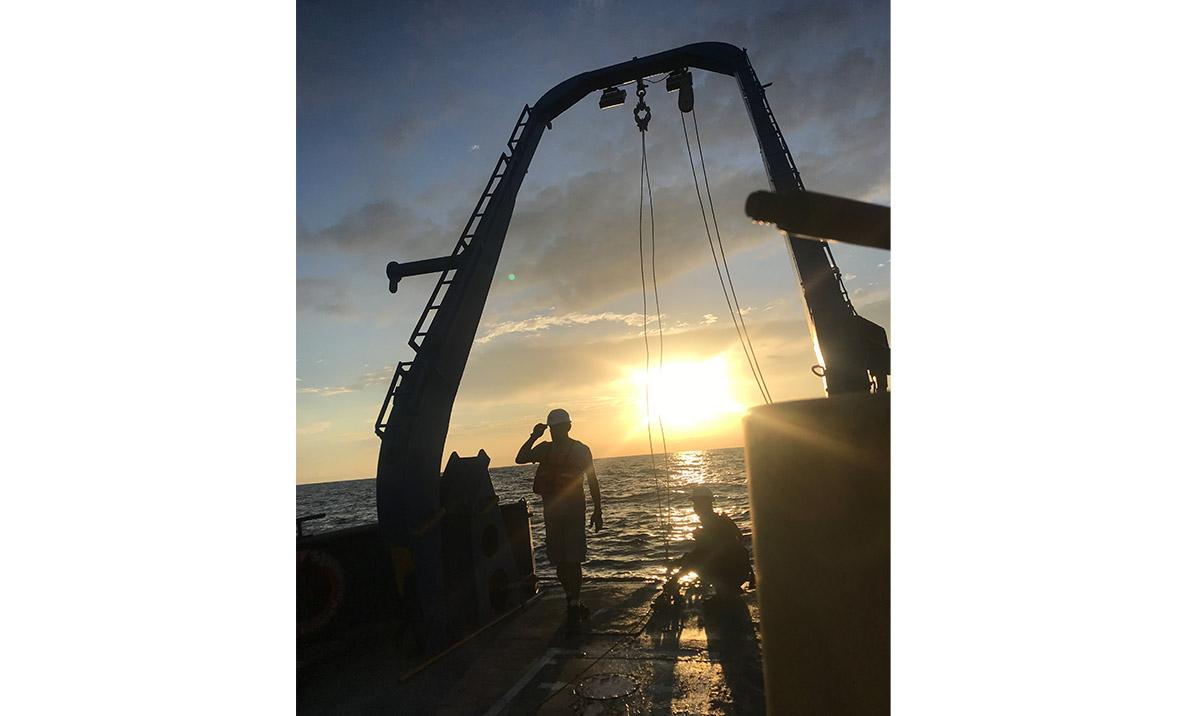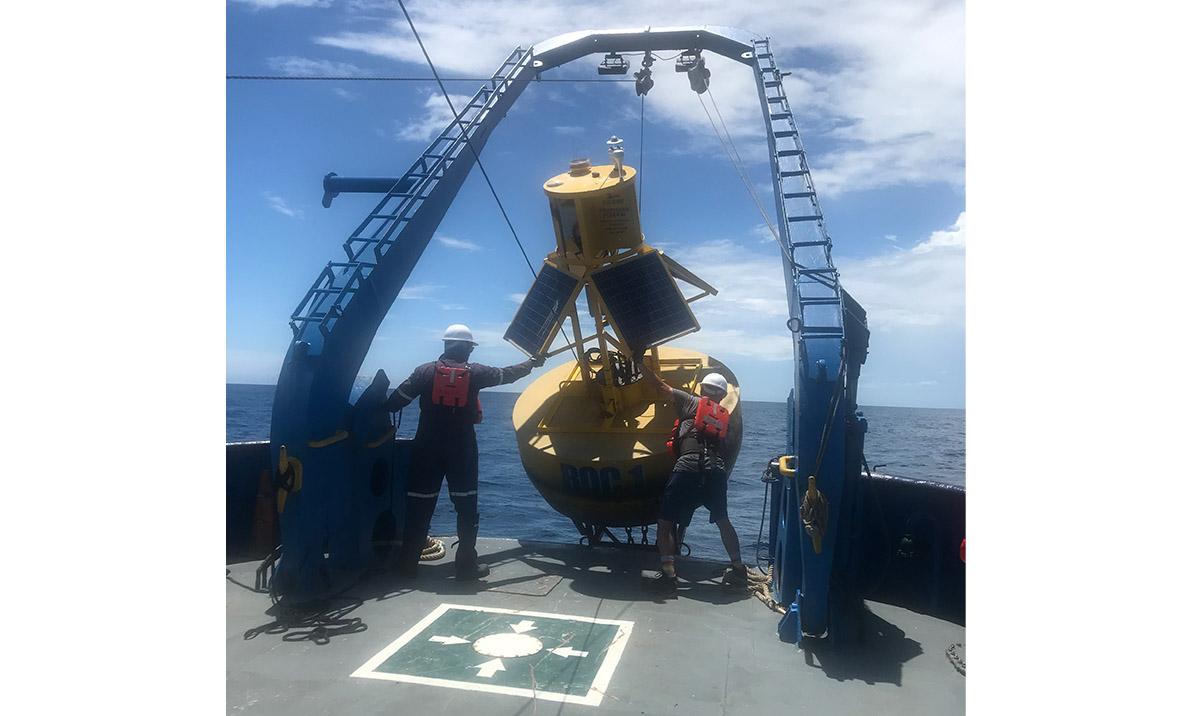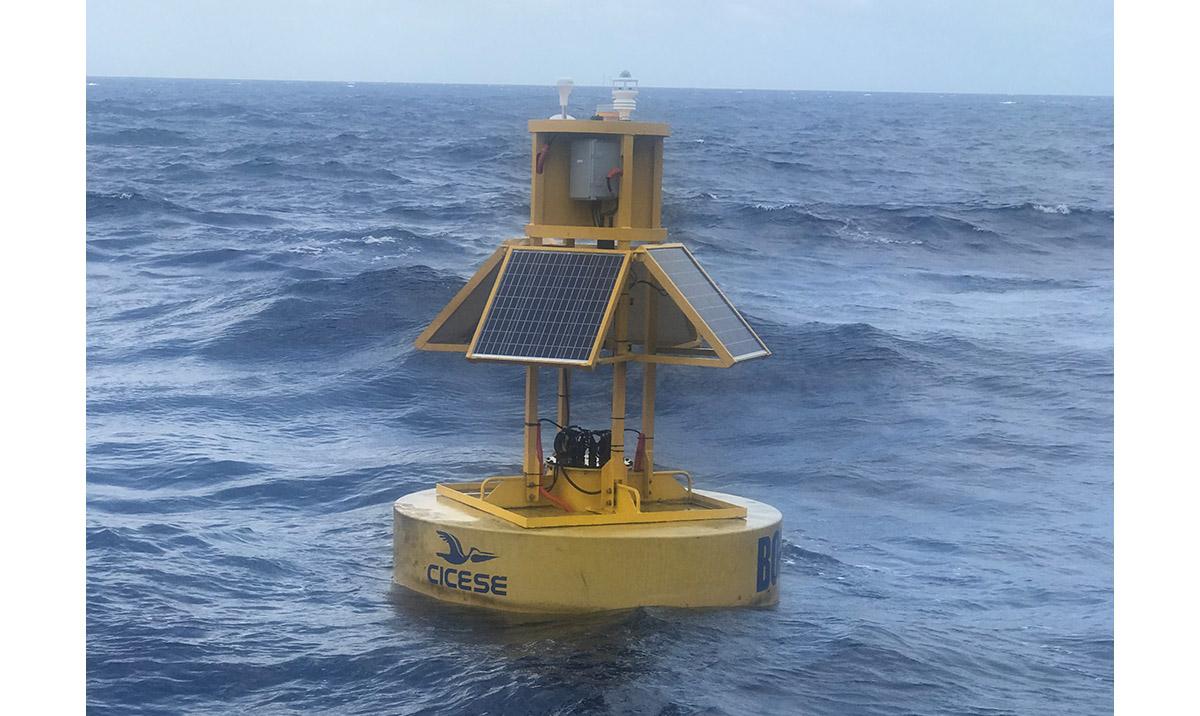Taking a sabbatical at EPCC
7 September 2023
Vanesa Magar, who has joined EPCC on sabbatical leave, introduces herself and her research.
It is a pleasure to introduce myself. I am currently on sabbatical leave at EPCC, until July 2024.
My background is in Physics and Applied Mathematics. I did my PhD in Biological Fluid Dynamics in the Department of Applied Mathematics and Theoretical Physics at the University of Cambridge. I then worked in Ocean Sciences and Coastal Engineering at the University of Bangor and the University of Plymouth, respectively, between 2002 and 2013.
In 2014 I moved to the Department of Physical Oceanography of CICESE, a National Research and Higher Education Center in Ensenada (Mexico), where I co-founded the GEMlab with Dr Markus Gross (see www.ventummaris.com/gemlab). While in CICESE, our group specialized in Wind Energy and Meteorology, in tandem with Marine Renewable Energy and Hydrodynamics.

Above: buoy recovery campaign in the Gulf of Mexico, June 30 2023. Many thanks are owed to those involved.
Markus and I had collaborated with EPCC in the past. Markus did his BSc and PhD at Heriot-Watt University on Computer Aided Engineering applied to laser materials processing, and he attended many HPC courses and workshops run by EPCC during his time in Edinburgh from 1998–2004. My collaborations with EPCC started at a much later stage, in 2011 and 2012, and through the Fellowship Programme of the Software Sustainability Institute.
I was awarded the Fellowship in 2011 and attended a Fellows event in Oxford where I made contact with EPCC staff including Neil Chue Hong and Mike Jackson. The Fellows Programme provided a platform for blogs on the exciting research we would see at various software users’ conferences. At the Fellows' meetings, we discussed the need for better software development training and software maintenance practices within the community.

Above: recovery of buoy BOC located at 18°55'26.4" N, 95°15'10.8" W, 275m depth. Buoy recovery campaign in the Gulf of Mexico, June 28 2023.
The years I spent collaborating with Markus in Earth Sciences and Renewable Energy showed me how game-changing an excellent computational training such as his could be for scientific research. His expertise naturally led us to work on complementary areas, as he adopted the role of GEMlab cluster administration and software support for the group, and I carried out more and more fieldwork. This division of labour was, without us really planning it, very evident after the summer of 2021, when I started to lead an oceanographic buoys observation network project for the Gulf of Mexico while he spent his time setting up projects in the GEMlab cluster and in a supercomputing facility in Puebla, Mexico.

Above: Recovery of buoy BOC located at 19°17'42" N, 92°36' 10.8" W, 107m depth. Buoy recovery campaign in the Gulf of Mexico, June 29 2023.
Markus’ untimely passing in January 2022 and my commitments with the Buoys project have caused delays with most of our computational projects. As the Buoys project was initially for two years, and given the need to continue Markus’ legacy, I ended up deciding that a one-year sabbatical leave at EPCC, combined with additional HPC and Data Science training, would help me pick up the computational research and continue publishing in that area. I should note that taking a sabbatical leave to carry on with collaborations in the UK had always been part of Markus’ and my plans, even if now these plans are somewhat different from the original ones.
Coming to EPCC to do computational research was motivated by the need to provide solid computational infrastructure and skills to the GEMlab for the future. Also, although I had naturally drifted into Energy Policy in the past few years, that research still had a computational component at its base. So, after the summer of 2022, I got in touch with Neil Chue Hong and Maureen Simpson, who supported my application to come to EPCC for a year, and simultaneously I applied for the part-time (online) HPC and Data Science MSc.
During the sabbatical leave, I will focus on Wind Energy and Meteorology projects using the Model for Prediction Across Scales – Atmosphere (MPAS-A), the atmospheric core of MPAS developed by the National Center for Atmospheric Research, NCAR, in the USA.
The model had been set up and tested on the GEMlab servers by Markus. In 2021, Markus started some validations of the MPAS model with data from the Mexican National Meteorological Service, with not very good results. One of the objectives of my sabbatical is to get our MPAS-A forecast back up on our servers. The other objective is to Integrate Data Assimilation methods into MPAS-A. For the data assimilation, we plan to use ensemble Kalman Filter methods. We will be performing some tests in ARCHER2.
Time permitting, I will also work on another project with the Weather Research and Forecast (WRF) model, also developed by NCAR, combined with machine learning methods. Markus had set up the model in our servers and in a National Supercomputing Laboratory in Mexico.
This research was part of a project collaboration with the Danish Technical University (DTU). We found that a low-resolution WRF model coupled with machine learning (ML) performs better than a standard nested WRF model. We also found that the WRF parameters that seem more relevant in the computation are related to the land surface temperature. Given that the standard WRF configuration is computationally costly, one idea is to use a low-resolution model combined with ML, to explore the effects of different land surface temperature assumptions on the wind speed predictions.
Besides the research programme for the sabbatical, I am also starting EPCC's online MSc this year.
I look forward to collaborating with colleagues at EPCC and learning more about Edinburgh, Scotland, and Scottish and other cultures. We want to visit castles, small villages, mountains, lochs, beaches, and islands, and go on sightseeing and whisky-tasting tours. Hiking and snowboarding trips are high on the list, given my 13-year-old's current snowboarding obsession. And now that the Sun is at a peak of solar activity, we may be lucky enough to see some Northern lights!
Author
Vanesa Magar
